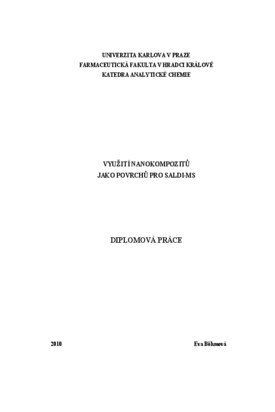Využití nanokompozitů jako povrchů pro SALDI-MS.
Využití nanokompozitů jako povrchů pro SALDI-MS
diploma thesis (DEFENDED)

View/
Permanent link
http://hdl.handle.net/20.500.11956/24689Identifiers
Study Information System: 67925
CU Caralogue: 990012966520106986
Collections
- Kvalifikační práce [6885]
Author
Advisor
Referee
Jáč, Pavel
Faculty / Institute
Faculty of Pharmacy in Hradec Králové
Discipline
Pharmacy
Department
Department of Analytical Chemistry
Date of defense
1. 6. 2010
Publisher
Univerzita Karlova, Farmaceutická fakulta v Hradci KrálovéLanguage
English
Grade
Excellent
Ionizace laserem za účasti matrice (matrix-assisted laser desorption/ionization, MALDI) patří mezi měkké (šetrné) ionizační techniky hmotnostní spektrometrie a je důležitá zejména pro analýzu biomolekul a syntetických makromolekul. Použití MALDI pro analýzu nízkomolekulárních sloučenin je však obtížné, protože ionty matrice interferují s analýzou malých molekul. Jako řešení tohoto problému bylo vyvinuto několik metod, které využívají ionizaci laserem za účasti povrchu (surface- assisted laser desorption/ionization, SALDI). Předmětem výzkumu této práce byly možnosti využití nanokompozitů složených z polylaktidu a nanočástic halloysitu, hydroxyapatitu, oxidu hořečnatého, montmorillonitu, oxidu křemičitého, nitridu křemičitého, oxidu titaničitého a grafitizovaných sazí (graphitized carbon black, GCB) jako povrchů pro SALDI. Intenzity signálů tří léčiv, acebutololu, karbamazepinu a propranololu, získané z těchto povrchů byly porovnány s intenzitami signálů získaných bez použití matrice z nerezové destičky pro MALDI. Intenzita signálu byla zvýšena pouze, když byly použity tyto tři nanokompozity: nanokompozit s obsahem 30% GCB, nanokompozit s 10% nitridu křemičitého a nanokompozit s 10% oxidu titaničitého, a analyty v koncentraci 150 ppm. Díky tomu, že polylaktid je biodegradabilní a lze ho získat z...
Matrix-assisted laser desorption/ionization (MALDI) is a soft ionization method used in mass spectrometry that is important for the analysis of biomolecules and large synthetic molecules. However, it is difficult to use MALDI for the analysis of small molecules because the matrix ions interfere with their analysis. Several surface-assisted laser desorption/ionization (SALDI) mass spectrometry methods have been developed as a solution to this problem. In this thesis, polylactide (PLA) nanocomposites containing halloysite nanoclay, hydroxyapatite, magnesium oxide, montmorillonite nanoclay, silicon dioxide, silicon nitride, titanium dioxide, and graphitized carbon black (GCB) nanoparticles were examined as surfaces for SALDI. The intensities of the signals of three human medicines: acebutolol, carbamazepine, and propranolol, obtained from these surfaces were compared to the signal intensities obtained from stainless steel MALDI plate without use of any matrix. The signal intensity was only enhanced when nanocomposites containing 30% GCB, 10% silicon nitride, and 10% titanium dioxide nanoparticles and analytes in concentration of 150 ppm were used. These results, together with the fact that PLA is a biodegradable polymer and can be obtained from renewable resources, make these materials potential...
